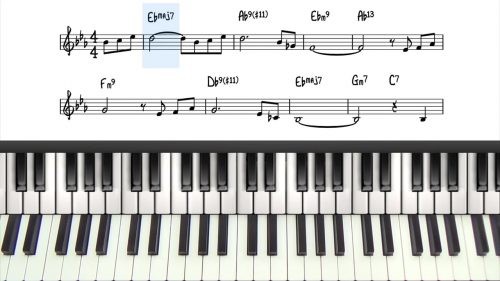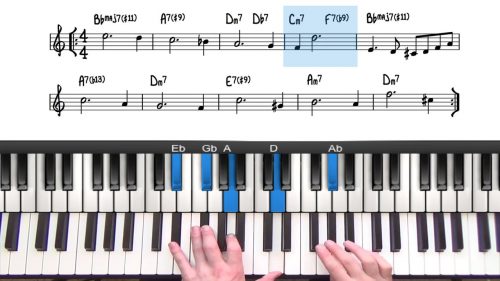Here’s That Rainy Day Tutorial
Here’s That Rainy Day is a jazz ballad composed by Jimmy Van Heusen. Written in the key of G Major, the tune follows a 32 measure A-B form.
It’s been widely recorded by many different jazz musicians over the years, the Bill Evans recording is definitely worth checking out if you haven’t already. The tune contains a lot of interesting melodies and harmonies which lends itself well to chord substitutions and reharmonisations.
We’re going to play once through with simple root based voicings and then the second time through we will add in chord extensions, alterations and also reharmonise sections of the tune.
We add dominant passing chords throughout the form and also sprinkle in applications of suspended harmony resolving to altered dominant chords.
It’s also a nice to apply inner voice movement. There is a lot of space in the harmony which can be filled with the minor line cliche and also 5-#5-6 movement over the major chords.
Practice Tips
-
This tune has been recorded by many notable jazz musicians... some of our favourite recordings are the versions by Chet Baker, Bill Evans, and Wes Montgomery.
-
Remember to spend the time to listen and study the recordings of the jazz standards you are playing.







This was a nice arrangement but I’m sorry to say, for me this is nothing new to what I’ve been doing for the past 10 years using upper structures and tritone dominant substitutions but I will admit for the new people and just learning the material it’s great. I find the programs ballade oriented and based on more of a groove piano as to what I’m looking for with more of a jazz groove with instructional material as the great jazz tunes such as confirmation, Solar, Lady Bird, One Finger Snap, Caravan,Night In Tunisiai,Giant Steps and tunes of this nature for students wanting to study jazz. This is solely my opinion .Thank you for your efforts you are putting forward but have to withdraw my membership at the present. Thankyou.
Hi George, thanks for the comment and sorry to hear that the ballad tutorials are not what you are looking for. You can find a number of up tempo jazz standard tutorials (Beautiful Love, Autumn Leaves, All The Things You Are, Someday My Prince Will Come, Have You Met Miss Jones) in the Pro Member Area. I’m trying to create a well-balanced program and so I’ll be adding more up-tempo tunes and also latin/bossa arrangements. All the best, Hayden
your beautiful and simple arrangements and these slow ballads are the reason I WILL renew my membership every year. I searched high and low for someone like you. There are a zillion other fast busy and complicated jazz instructors online to choose from. I do like the idea of adding some Bossa Nova…. Keep bringing these ballads Hayden. :)
Hey Lori, thanks for the comment. I’m working through lots of lesson requests and trying to cater for everyones different tastes! :-) And yes sure thing… A Bossa Nova tutorial is in the pipeline. Cheers, Hayden
I’m one of the “new people just learning”. Actually I’ve been trying to learn how to play like this for years and just never could find anyone who could help me. When I found PianoGroove, it was like I died and went to jazz piano standard heaven. It’s been a dream come true. Hayden, please keep doing exactly what you’re doing. I think these lessons are fantastic and very helpful and enjoyable. You’re the best!
In this lesson, all the things you do to make the arrangement more interesting and professional, things like moving inner voicings around over a static melody note, inserting chords a half step above, minor line cliche, etc. is what I find most helpful. Thank you!
Hi Mark, thanks for the comment. I’m really happy you found the tutorial helpful and enjoyable… I put a lot of work into the planning, editing and formatting of each lesson so it’s great to hear it’s appreciated :-)
The introduction video we talked about a couple of months back is almost finished… it gives an overview of my background, what inspired me to create PianoGroove and also my future plans for the development of the website and the community here. It will be ready in the coming weeks and published on the Member Dashboard so keep your eyes out for it!
Always remember that the things I talk about in this lesson can be applied to any jazz standard (moving inner voices around over a static melody note, inserting chords a half step above, minor line cliche, etc). I’d highly recommend that you experiment with these things yourself… maybe flick through some of the old arrangements you’ve learnt and look out for opportunities where these concepts could work. That way, you’re actively trying to apply these concepts yourself which I find yields the greatest results in terms of adding them to your ‘arsenal’ of arranging skills. You will also learn a lot in the process of discovery!
All the best,
Hayden
Agree!!
It’s awesome to hear a great song like this one on Pandora or YouTube and then come to your website and learn that you already have a tutorial posted. This is a simple and beautiful song. Gotta learn this one. Thanks again.
Awesome.
Check out the Bill Evans / Jim Hall version, that’s one of my favourites.
Such great interplay between 2 fantastic musicians!
Cheers,
Hayden
I just this morning, stuck at home because of the COVID pandemic came across this tune sang by the Eternal Ella. and, what is so much better, found it on the PG!!! What a fine set of harmonies and I was even able to play it after watching your, Hayden, lesson and even my wife did not leave the room!!! Thanks Hayden for yet another fine lesson.
Smole
Hi Smole 👋
Yes it’s a crazy situation with the virus. I’m grateful we all have music to keep us occupied during the confinement!
I’m glad you liked the arrangement… it’s a beautiful tune.
And happy to hear your wife approves of the arrangement.
Cheers!
Hayden
Hi Hayden, can you please explain why in the first bar on the F#min6 you play F# and D in the base, the 6th of F# is D# thank you, Regards mark
Hi Mark,
Yes I agree this is confusing. I’m unsure what my logic was when I added the F#m6 chord symbol.
The simpler way to look at this is Gmaj7/F#, or even D/F#, which creates the step-wise bass line from Gmaj7 down to the F-6.
I should have explained it that way initially! I will look into this further and perhaps I can find the record(s) I was listening to at the time of creating the arrangement.
I hope the above helps in the interim.
Cheers,
Hayden
ps. we have an exciting live seminar on Monday on the pianist Eddie Higgins and the tune “In A Sentimental Mood” – pianogroove.com/live-seminars/how-to-play-like-eddie-higgins/ – hope to see you there.
Thanks Hayden, for response.
This is yet another example of the many beautiful arrangements you’ve created for us Hayden. Many, many thanks!
Just noting that in bar 24 of the transcription, it appears that what should be a G7(#11, b9) — or G13(#11, b9) actually — is spelled incorrectly, as a G7(#11, #9).
Cheers.